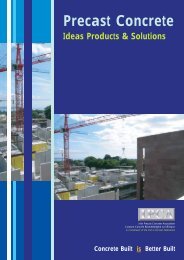Concrete Today May 2010 - the Irish Concrete Federation
Concrete Today May 2010 - the Irish Concrete Federation
Concrete Today May 2010 - the Irish Concrete Federation
Create successful ePaper yourself
Turn your PDF publications into a flip-book with our unique Google optimized e-Paper software.
concrete today - fibre reinforced polymer<br />
FRP reinforced laterally restrained slabs for<br />
sustainable structures<br />
G Tharmarajah, S.E Taylor, D.J Robinson and D.J Cleland<br />
School of Planning, Architecture and Civil Engineering, Queen’s University Belfast<br />
Fibre reinforced polymer (FRP)<br />
reinforcement is a corrosion free<br />
alternative to steel in reinforced concrete<br />
structures to meet <strong>the</strong> structural and<br />
safety requirements. FRP is a light weight<br />
material with higher strength capacities,<br />
but <strong>the</strong> brittle behaviour and low modulus<br />
of elasticity were <strong>the</strong> perceived drawbacks<br />
of this composite material. Compressive<br />
membrane action (CMA) or arching<br />
action has a beneficial influence on <strong>the</strong><br />
flexural strength of laterally restrained<br />
slabs. It has been recognised for some time<br />
that restrained slabs behave differently<br />
to simply supported slabs and thus FRP<br />
reinforcement may perform well in<br />
structure which develop CMA.<br />
Introduction<br />
<strong>Concrete</strong> can be a very durable<br />
material. However, <strong>the</strong> corrosion of<br />
steel reinforcement can cause severe<br />
deterioration to reinforced concrete<br />
structures which can result in spalling<br />
and cracking of concrete (see Figure 1).<br />
Extreme environmental conditions cause<br />
chloride intrusion and carbonation in<br />
concrete structures which subsequently<br />
lead to expansive corrosion of steel.<br />
Expansive corrosion in steel reinforcement<br />
significantly reduces <strong>the</strong> design life and<br />
durability of concrete structures. In some<br />
cases repair and maintenance costs, as a<br />
direct result of deterioration caused by steel<br />
corrosion exceed <strong>the</strong> original cost of <strong>the</strong><br />
structure(1).<br />
Fibre reinforced polymer (FRP)<br />
reinforcement, stainless steel and epoxy<br />
coated steel reinforcement are alternative<br />
reinforcement materials to replace<br />
high yield steel in reinforced concrete<br />
structures(2). Among <strong>the</strong> alternatives,<br />
glass fibre reinforced polymer (GFRP)<br />
reinforcement has good strength, is cost<br />
effective, durable and widely available.<br />
Laterally restrained slabs are inherent<br />
in much of bridge deck construction. To<br />
date, <strong>the</strong> benefits of arching action have<br />
not been fully realised to produce highly<br />
durable FRP reinforced concretes slabs in<br />
Ireland and <strong>the</strong> rest of Europe. Therefore,<br />
this research investigates how <strong>the</strong> benefits<br />
of arching action can be incorporated<br />
to effectively use GFRP reinforcement<br />
Figure 1: Chloride induced corrosion damage<br />
(Courtesy: http://cce.oregonstate.edu)<br />
to replace conventional steel without<br />
compromising <strong>the</strong> strength, serviceability<br />
and safety of reinforced concrete slabs.<br />
Previous research has outlined preliminary<br />
findings(3, 4, 5) and this paper gives an<br />
overview of recent research at Queen’s<br />
University Belfast.<br />
Research Programme<br />
The research programme is aimed at<br />
investigating <strong>the</strong> effect of GFRP in laterally<br />
restrained concrete slab strips typical of<br />
bridge deck slabs in Y beam bridges in<br />
Ireland and <strong>the</strong> UK. Several parameters<br />
were investigated including bar size,<br />
different reinforcement percentage,<br />
spacing, position and size. The slabs<br />
were loaded with a knife edge line load<br />
representing local wheel loading on a<br />
bridge deck slab at <strong>the</strong> mid-span of <strong>the</strong> slab<br />
using an accurately calibrated hydraulic<br />
actuator (see Figure 2 & 3). A steel rig was<br />
used to represent <strong>the</strong> vertical restraint of<br />
Restraint,<br />
K<br />
b=475mm<br />
h=150mm<br />
d=effective<br />
Figure 2 – Model Test Slab Set-up<br />
Load, PkN<br />
<strong>the</strong> supporting Y beams and <strong>the</strong> horizontal<br />
restraint of <strong>the</strong> surrounding slab.<br />
Given concerns by some researchers and<br />
practitioners over <strong>the</strong> service behaviour<br />
of GFRP reinforced concrete slabs, <strong>the</strong><br />
deflection and crack width and pattern<br />
were fully investigated within <strong>the</strong> service<br />
load range. Deflection was observed<br />
directly below <strong>the</strong> loading line using two<br />
50mm displacement transducers. A steel<br />
rig was used to represent <strong>the</strong> supporting Y<br />
beams and surrounding area of unloaded<br />
slab. The displacement of <strong>the</strong> rig was<br />
monitored using two 25mm transducers<br />
placed at both ends of <strong>the</strong> rig to check<br />
for any lateral expansion. The strain<br />
development on GFRP bars was monitored<br />
using embedded Fibre Optic Sensors (FOS)<br />
and Electronic Resistant Strain (ERS)<br />
gauges. Crack width development was<br />
recorded using vibrating wire gauges placed<br />
perpendicular to <strong>the</strong> primary cracks formed<br />
during <strong>the</strong> test.<br />
1425mm clear span<br />
h<br />
concrete today<br />
21





